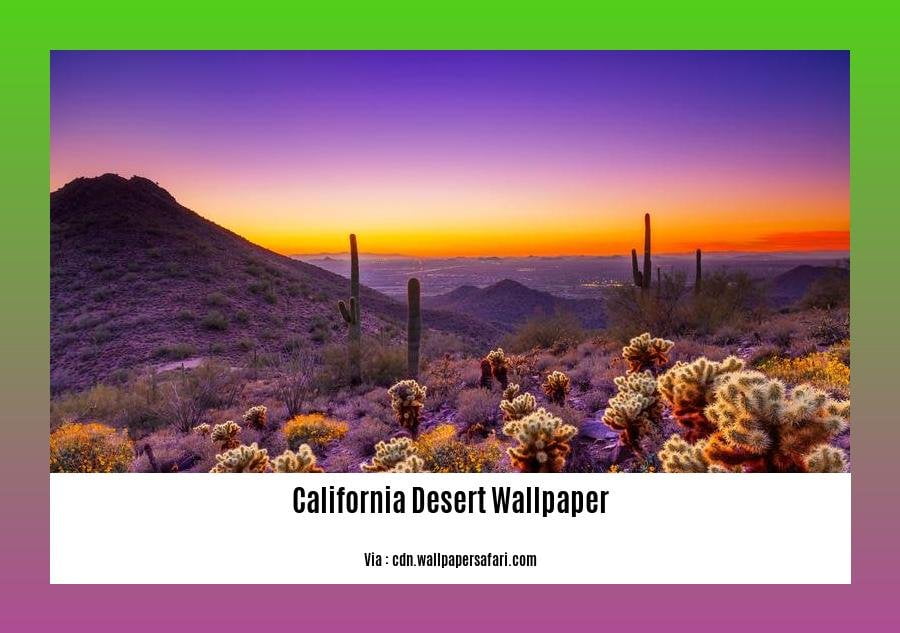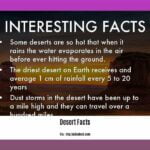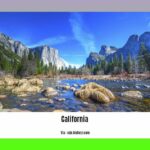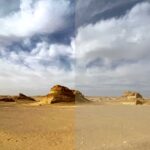Unveiling the Enigmatic Charms: California Desert Region Interesting Facts
Discover the allure and mystique of the California desert region as we embark on a journey through its captivating landscapes, abundant wildlife, and rich cultural heritage. In this article, we will delve into the lesser-known aspects of this arid wilderness, uncovering fascinating facts and hidden gems that will leave you awestruck. Immerse yourself in the enchanting world of the California desert, where every dune holds a story and every vista offers a glimpse into the extraordinary. Get ready to be captivated by the intriguing secrets that lie within the heart of this remarkable corner of the world.
Key Takeaways: California Desert Region Interesting Facts
- The California Desert region consists of three main deserts: The Great Basin Desert, Colorado Desert, and Mojave Desert.
- Death Valley, located in the Mojave Desert, holds the record for being the hottest and driest place in North America.
- Joshua Tree National Park, a part of the California Desert region, is famous for its giant boulders and alien-like yucca plants.
- The Mojave Desert is home to the threatened species, the desert tortoise.
- Covering approximately 25% of the state’s total land area, the California desert region is one of the largest desert regions in the United States.
- The Colorado Desert features the Salton Sea, a large saline lake.
- Springtime in the desert brings vibrant wildflowers after winter rains.
- Notable national parks in the California Desert region include Joshua Tree National Park, Death Valley National Park, and Mojave National Preserve.
Sources:
– Visit California – Discover the Deserts
– Factsmania – California Desert Facts
California Desert Region Interesting Facts

The California Desert region is a captivating corner of the world, filled with mesmerizing landscapes, awe-inspiring wildlife, and rich cultural heritage. Here are some intriguing facts that unveil the enigmatic charms of this arid wilderness:
Three Unique Deserts
The California Desert region encompasses three main deserts: the Great Basin Desert, Colorado Desert, and Mojave Desert. Each desert has its own distinctive characteristics, offering a diverse range of ecosystems and natural wonders.
Death Valley: The Hottest and Driest Place in North America
Located in the Mojave Desert, Death Valley holds the record for being the hottest and driest place in North America. With scorching temperatures and minimal rainfall, this extreme environment showcases the resilience of life in the face of adversity.
Joshua Tree National Park: Home to Alien-Like Yucca Plants
One of the highlights of the California Desert region is Joshua Tree National Park. This unique national park is known for its giant boulders and otherworldly yucca plants, which seem to belong to a different planet. Exploring this extraordinary landscape is like stepping into a surreal dream.
The Threatened Desert Tortoise
The Mojave Desert is home to the desert tortoise, a threatened species. These gentle creatures symbolize the fragile balance of the desert ecosystem and serve as a reminder of the importance of conservation efforts in preserving their habitat.
Vast and Breathtaking Land Area
Covering approximately 25% of California’s total land area, the California Desert region is one of the largest desert regions in the United States. Its expansive expanse stretches as far as the eye can see, offering a vast canvas of natural beauty to explore.
The Salton Sea: A Saline Lake in the Colorado Desert
Nestled in the Colorado Desert, the California Desert region is home to the Salton Sea, a large saline lake. Its unique composition creates a habitat for a variety of wildlife, making it a haven for birdwatchers and nature enthusiasts.
Burst of Color: Springtime Wildflowers
Contrary to popular belief, the desert can come alive with vibrant colors. After winter rains, the California Desert region experiences a burst of springtime wildflowers, adding a vivid palette of colors to the arid landscape. It’s a sight that showcases the beauty of nature’s resilience and adaptation.
Notable National Parks
The California Desert region boasts several notable national parks, including Joshua Tree National Park, Death Valley National Park, and Mojave National Preserve. These protected areas offer diverse ecosystems, breathtaking vistas, and opportunities for outdoor adventure.
The captivating wonders found in the California Desert region make it an enticing destination for explorers seeking to unravel its hidden secrets. From the otherworldly landscapes of Joshua Tree National Park to the extreme conditions of Death Valley, there’s always something extraordinary to discover in this remarkable corner of the world.
Sources:
- Visit California – Discover the Deserts
- Factsmania – California Desert Facts
Calgary Chinatown has a fascinating history that is waiting to be discovered. Learn more about the rich cultural heritage and stories behind this vibrant community by clicking here.
Experience the wonder of California’s desert region with these fun facts. Discover hidden treasures and unique landscapes that will leave you in awe. Start your adventure by clicking here.
Are you wondering if it’s possible to drive through Death Valley? Find out the answer to your burning question and embark on an epic road trip adventure. Satiate your curiosity by clicking here.
Remarkable Wildlife and Plant Species

The California Desert region is not only a captivating landscape of arid wilderness but also a haven for remarkable wildlife and plant species. From rare animals to unique flora, this region boasts a rich biodiversity that is worth exploring. Let’s dive into the fascinating world of these incredible inhabitants.
The Joshua Tree: A Symbol of Resilience
One of the most iconic species found in the California Desert region is the Joshua Tree. These peculiar-looking trees with their twisted branches and spiky leaves create a surreal landscape that is instantly recognizable. They are named after the biblical figure Joshua, as their outstretched limbs resembled the prophet reaching towards the heavens. Despite their otherworldly appearance, Joshua Trees are not trees at all, but rather a type of yucca plant. These plant species can live for hundreds of years, surviving in the harsh desert conditions. Their blossoms, which appear in the spring, attract pollinators such as the Yucca Moth, which is the sole pollinator of these magnificent trees.
Desert Tortoise: A Threatened Treasure
Another remarkable species in the California Desert region is the desert tortoise. This resilient reptile has become a symbol of the fragile balance of the desert ecosystem. With their flat, dome-shaped shells and strong legs, desert tortoises have adapted to the extreme temperatures and arid conditions. Unfortunately, due to habitat loss, climate change, and illegal collection, the desert tortoise population has been declining, making them a threatened species. Conservation efforts are in place to protect these remarkable creatures and ensure their survival in their natural habitat.
Wildflowers: Nature’s Colorful Canvas
Contrary to popular belief, the desert is not devoid of color. In fact, after winter rains, the California Desert region experiences a burst of vibrant wildflowers, transforming the arid landscape into nature’s colorful canvas. The Desert Lily, with its delicate white petals, and the Mariposa Lily, with its vibrant orange or yellow flowers, are just a few of the stunning wildflower species that grace the desert floor. This ephemeral spectacle is a testament to the resilience and adaptability of plant life in the face of adversity.
Key Takeaways:
- The Joshua Tree is an iconic plant species in the California Desert region, named after the biblical figure Joshua.
- The desert tortoise is a threatened species that symbolizes the delicate balance of the desert ecosystem.
- After winter rains, the desert comes alive with a vibrant display of wildflowers.
- The California Desert region is home to a diverse range of plant and animal species that have adapted to survive in arid conditions.
Sources:
– Sciencing: California Desert Animals & Desert Plants
– Tourism Teacher: 25 Interesting Facts About the Deserts in California
Significance of the California Desert Region to Native American Tribes
The California Desert region holds immense significance to Native American tribes that have called it home for thousands of years. The land, with its mesmerizing landscapes and vast expanses, has played a vital role in shaping the culture, spirituality, and history of these tribes. Let’s dive into the enriched significance of the California desert region to Native American tribes.
Native American Tribes and Ancient Inhabitants
California Indians, the Native American peoples who traditionally resided in the area corresponding to present-day California and northern Baja California, inhabited the California Desert region before the arrival of European settlers. Their rich cultural and historical heritage is deeply intertwined with the desert’s landscapes and resources.
Timbisha Shoshone Tribe: Guardians of the Desert
One of the most prominent Native American tribes associated with the California Desert region is the Timbisha Shoshone. They have a deep spiritual connection with the land and have inhabited the region for over 10,000 years. Their ancestors thrived in harmony with the desert’s challenging conditions, leaving behind a legacy that still resonates today.
Cultural and Historical Significance
The California Desert region, encompassing the Great Basin Desert, Colorado Desert, and Mojave Desert, holds immense cultural and historical significance for Native American tribes. Ancient petroglyphs scattered throughout the region provide a fascinating glimpse into the lives and stories of the region’s early inhabitants. These rock carvings serve as a testament to the rich cultural heritage of the Native American tribes and their deep-rooted connection to the land.
Challenging Times: Termination Policies
Sadly, the Native American tribes in the California Desert region faced difficult times in the mid-20th century. Termination policies implemented during this period aimed to assimilate tribes into mainstream society but failed to improve their socioeconomic and political power. These policies disrupted Native American communities and threatened to erase their cultural identity.
Preservation by National Park Service
Recognizing the cultural and historical significance of the California Desert region, the National Park Service has taken steps to preserve and honor the Native American heritage that thrived there for centuries. By protecting sacred sites and establishing partnerships with Native American communities, the National Park Service works towards acknowledging and preserving the profound significance of the region to Native American tribes.
Key Takeaways:
- The California Desert region holds deep cultural and historical significance to Native American tribes.
- The Timbisha Shoshone Tribe has inhabited the region for over 10,000 years, showing a continuous connection to the land.
- Ancient petroglyphs scattered throughout the California Desert region provide insights into the lives and stories of early Native American inhabitants.
- Termination policies in the mid-20th century disrupted Native American communities but failed to assimilate them fully.
- The National Park Service recognizes and safeguards the cultural and historical heritage of the California Desert region and its importance to Native American tribes.
Sources:
– National Park Service: “Beyond the Surface: National Recognition of the California Deserts”
– Softschools.com: “California Desert Region Facts”
Popularity of the California Desert Region for Outdoor Activities and Adventures
The California desert region has gained immense popularity among outdoor enthusiasts and adventure seekers. Its unique landscapes, diverse wildlife, and rich cultural heritage make it a haven for those seeking thrilling outdoor activities. Let’s dive into the reasons behind the popularity of this mesmerizing desert region.
A Playground for Outdoor Activities and Adventures
The California desert region offers a wide range of outdoor activities and adventures that cater to all levels of thrill-seekers. From hiking through scenic trails to exploring vast sand dunes, there is something for everyone to enjoy. The popularity of this region can be attributed to the following factors:
Hiking and Backpacking: The desert’s rugged terrain is perfect for hiking and backpacking enthusiasts. Trails like those in Mojave National Preserve and Anza-Borrego Desert State Park provide stunning views and opportunities to explore the unique desert flora and fauna.
Rock Climbing: With its impressive rock formations and boulders, Joshua Tree National Park has become a mecca for rock climbers. The park offers a variety of routes and challenges for climbers of all skill levels.
Off-Roading and Jeep Tours: The vast expanses of the California desert are a paradise for off-road enthusiasts. Visitors can explore the desert’s remote corners and witness its captivating beauty by embarking on off-road adventures or guided jeep tours.
Wildlife Viewing: The desert region is home to a diverse array of wildlife, including bighorn sheep, desert tortoises, and elusive desert foxes. Wildlife enthusiasts can enjoy observing these unique creatures in their natural habitat.
Stargazing: The clear, unpolluted skies of the California desert provide breathtaking opportunities for stargazing. Visitors can witness the stunning celestial display and learn about the constellations under the vast desert sky.
Photography: The unique landscapes and mesmerizing natural attractions of the California desert region make it a prime destination for outdoor photographers. From capturing the golden hues of sunrise to the vibrant colors of wildflowers, the desert offers endless opportunities for stunning photography.
Key Takeaways:
- The California desert region is a popular destination for outdoor activities and adventures.
- Hiking, rock climbing, off-roading, wildlife viewing, stargazing, and photography are among the top activities in the region.
Now that we have explored the popularity of the California desert region for outdoor activities and adventures, it’s clear that this arid wilderness holds a wealth of opportunities for those seeking thrilling experiences in a captivating and diverse natural landscape. Whether it’s exploring rugged trails, witnessing majestic wildlife, or immersing oneself in the serenity of the desert, this remarkable region never fails to leave a lasting impression on its visitors. So, pack your gear, embrace the spirit of adventure, and embark on a journey to the enchanting California desert region.
FAQ
Q1: What are the three main deserts in the California Desert region?
A1: The California Desert region consists of the Great Basin Desert, Colorado Desert, and Mojave Desert.
Q2: Which desert in the California Desert region holds the record for being the hottest and driest place in North America?
A2: Death Valley, located in the Mojave Desert, holds the record for being the hottest and driest place in North America.
Q3: What is a notable national park in the California Desert region?
A3: Joshua Tree National Park is a notable national park in the California Desert region, known for its giant boulders and alien-like yucca plants.
Q4: What threatened species can be found in the Mojave Desert?
A4: The desert tortoise, a threatened species, can be found in the Mojave Desert.
Q5: How much of California’s total land area does the California Desert region cover?
A5: The California Desert region covers approximately 25% of the state’s total land area, making it one of the largest desert regions in the United States.
















